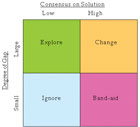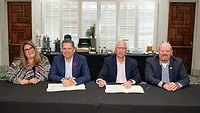Distribution Channels
A
key source of market share and revenue growth.

 Many companies assume that new products or technologies are
the passport to increased market share and revenue growth. But why do so many
promising new products fail? What’s more, are companies in the midst of a
new-product drought doomed to failure?
Many companies assume that new products or technologies are
the passport to increased market share and revenue growth. But why do so many
promising new products fail? What’s more, are companies in the midst of a
new-product drought doomed to failure?
New products and technologies are a definite plus. However, many seemingly viable introductions fail because manufacturers don’t understand the complexities of distribution channels. Still, even without a compelling new product, astute manufacturers can use channel strategies to find profitable sources of revenue growth, especially during sluggish growth periods. Unfortunately, many executives with an engineering or sales background don’t have experience in “channel strategy,” which can cost their companies a fortune.
Recently, a large industrial-components manufacturer recognized this dilemma. It engaged Frank Lynn & Associates with one major objective: How can we develop an aggressive growth strategy in a mature market to jump start revenue and market-share growth?
This client was in the revenue doldrums. They faced new, low-cost competitors, had no new “whiz-bang” products, and relied on stale management solutions that were safe but failed to deliver the needed results. In this environment, management’s revenue growth goals of 11% per year seemed unlikely - and maybe even unachievable.
To determine if the growth target was possible, the Frank Lynn team conducted an evaluation of the company’s product portfolio, competitive situation and go-to market strategy. The team asked the following questions.
While closing the key “Change” gaps became the strategy, the real win for the company was executing an effective implementation - the so-called “boots on the ground” phase. Specialized channel partners were not equally dispersed around the country. The same was true of cherry-pickers. What the client didn’t fully understand was that they needed a national go-to market strategy, but achieving their growth target could only be accomplished at the local level.
The national strategy included a recruitment pitch and incentives for specialized resellers. It also included a redesigned channel-compensation program that put more emphasis on full-line sales than sheer volume. However, the strategy lacked the specific direction needed for each territory manager and failed to account for local market differences. The client’s salespeople needed to know where to find the specialized channels and cherry-pickers.
This need led the project to the next step. Frank Lynn used its proprietary Territory Share Assessment (TSA) tool to build a bridge between the national strategy and the client’s local market characteristics.
The TSA tool is designed to help companies get detailed data for revenue, market share, and market coverage by channel type, and by customer segment. The TSA involves:
Faced with the actual data, management found the conviction to put forth a complete reallocation of marketing and distribution resources. Staffing and budget were applied in some sales channels and geographic markets that had previously received little attention. At the same time, some regions that were previously considered over-funded got even more funding if the data supported the case. Sales territories, compensation and goals were adjusted to focus on the specialization and cherry-picking behavior. Similar programs were instituted at the channel level.
The local market data created a strong internal focus. Programs were carefully coordinated throughout the product, market and sales organizations - teams that had previously worked by their own agendas.
Management forecasted incremental revenues in the first local market of $750,000 in the first year. However, they hit that target nine months from the date we delivered our first “Change” recommendations.
The client systematically implemented the local market process in two separate territories. During that time, they formalized the process steps, defined the internal and external information requirements and trained key client personnel to lead the implementation program in all remaining important territories.
The key to success is first designing the big-picture, national go-to-market strategy and then designing a program that can translate the strategy into local market tactics, which is where the actual growth occurs.
With proprietary tools like its TSA approach and over 30 years of focused sales channel experience, Frank Lynn & Associates have brought a data- and market-driven emphasis to decisions that many companies typically make on the fly.
For more information, visit www.franklynn.com. To contact the author, e-mail jhenderson@franklynn.com.


New products and technologies are a definite plus. However, many seemingly viable introductions fail because manufacturers don’t understand the complexities of distribution channels. Still, even without a compelling new product, astute manufacturers can use channel strategies to find profitable sources of revenue growth, especially during sluggish growth periods. Unfortunately, many executives with an engineering or sales background don’t have experience in “channel strategy,” which can cost their companies a fortune.
Recently, a large industrial-components manufacturer recognized this dilemma. It engaged Frank Lynn & Associates with one major objective: How can we develop an aggressive growth strategy in a mature market to jump start revenue and market-share growth?
This client was in the revenue doldrums. They faced new, low-cost competitors, had no new “whiz-bang” products, and relied on stale management solutions that were safe but failed to deliver the needed results. In this environment, management’s revenue growth goals of 11% per year seemed unlikely - and maybe even unachievable.
To determine if the growth target was possible, the Frank Lynn team conducted an evaluation of the company’s product portfolio, competitive situation and go-to market strategy. The team asked the following questions.
- Where could the 11% per year growth come from? Product tweaks? Geographic expansion? New customer segments? New brands or targeting of new competitors? New channels?
- Where does the company have coverage gaps?
- What are unmet customer needs?
- Where are competitors weakest?
While closing the key “Change” gaps became the strategy, the real win for the company was executing an effective implementation - the so-called “boots on the ground” phase. Specialized channel partners were not equally dispersed around the country. The same was true of cherry-pickers. What the client didn’t fully understand was that they needed a national go-to market strategy, but achieving their growth target could only be accomplished at the local level.
The national strategy included a recruitment pitch and incentives for specialized resellers. It also included a redesigned channel-compensation program that put more emphasis on full-line sales than sheer volume. However, the strategy lacked the specific direction needed for each territory manager and failed to account for local market differences. The client’s salespeople needed to know where to find the specialized channels and cherry-pickers.
This need led the project to the next step. Frank Lynn used its proprietary Territory Share Assessment (TSA) tool to build a bridge between the national strategy and the client’s local market characteristics.
The TSA tool is designed to help companies get detailed data for revenue, market share, and market coverage by channel type, and by customer segment. The TSA involves:
- Interviews with key resellers (both the company’s and competitors’) in selected local markets.
- Interviews with a sample of target end-user customers in the same local markets.
- Identification of new (specialized) resellers to fill gaps, or existing resellers to target with new programs (e.g., anti-cherry-picking programs).
- The development of local market models to predict conditions in other geographic regions (such as the ratio of a certain type of customer to a certain type of reseller).
Faced with the actual data, management found the conviction to put forth a complete reallocation of marketing and distribution resources. Staffing and budget were applied in some sales channels and geographic markets that had previously received little attention. At the same time, some regions that were previously considered over-funded got even more funding if the data supported the case. Sales territories, compensation and goals were adjusted to focus on the specialization and cherry-picking behavior. Similar programs were instituted at the channel level.
The local market data created a strong internal focus. Programs were carefully coordinated throughout the product, market and sales organizations - teams that had previously worked by their own agendas.
The Results
In the client’s first major geographic target market, the market research and analysis identified two new sales channel partners that needed to be pursued. We worked with management to successfully establish a new relationship with these distributors, and the client realized immediate sales and market share growth.Management forecasted incremental revenues in the first local market of $750,000 in the first year. However, they hit that target nine months from the date we delivered our first “Change” recommendations.
The client systematically implemented the local market process in two separate territories. During that time, they formalized the process steps, defined the internal and external information requirements and trained key client personnel to lead the implementation program in all remaining important territories.
The key to success is first designing the big-picture, national go-to-market strategy and then designing a program that can translate the strategy into local market tactics, which is where the actual growth occurs.
With proprietary tools like its TSA approach and over 30 years of focused sales channel experience, Frank Lynn & Associates have brought a data- and market-driven emphasis to decisions that many companies typically make on the fly.
For more information, visit www.franklynn.com. To contact the author, e-mail jhenderson@franklynn.com.
Looking for a reprint of this article?
From high-res PDFs to custom plaques, order your copy today!





